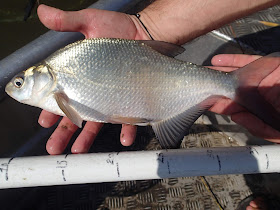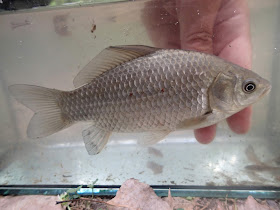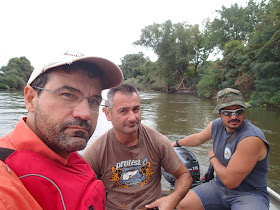Sampling in September 2018
The Evros, Maritsa, Meriç...In Greece it is a shared river. It has about ten major tributaries entering the main stem from Greek territory. Shared with Turkey and Bulgaria. It is my favorite river.
We have been doing a lot of work here because we love big rivers, and this is perhaps the last "sturgeon river" in the Med and one of the richest in terms of a full sweep of biodiversity - in the Greek part, from its upland tributaries to the Delta.
I'm posting snap shots from our September HCMR visit. Water Framework Directive boat-fishing in the river at four sites (see our map below - near the end of the pics). And many thanks to the Hellenic Army that helped us in this peaceful endeaver.
 |
| The Evros is just full of fish! You definately need to nets here... |
 |
| Sometimes they don't fit in the net: European wells (Silurus glanis). |
 |
| One of the most interesting predatory fishes in the Evros: Asp (Leuciscus aspius). |
 |
| Common Bream (Abramis brama)- not at all common in Greek river waters. |
 |
| The Pikepearch (Sander lucioperca), another predatory species - this is its fry! |
 |
| Prussian carp (Carassius gibelio) - an alien from the orient that has led to the extirpation of its wild native cousin, the Crussian Carp - now a mystery fish for Greece (and probably extinct). |
 |
| Evros_md (see map below). First site on the Evros across from the Turkish border, south of Edirne/Adrianoupolis. |
 |
| Evros_up is across from the Bulgarian border. Here you can easily stray into uncharted waters if you are not careful - I think we officially visited Bulgaria on this survey. |
 |
| Erythro_dw is near the town of Didymoteicho. Water abstraction and pollution creates this kind of situation: a very interesting site for bioassessment (only 13 spp here). |
 |
| Erythro_dw and the common water chestnut (Trapa natans). |
 |
| Erythro_dw: negotiating with the trees with military help, before we can dump the boat in the river. |
 |
| European rudd (Scardinius erythophthalmus). |
 |
| Top-mouth Gudgeon (Pseudorasbora parva), one of the most threatening aind notorius invasive aliens species in Europe. |
 |
| Getting boats ready. Ours is a german-made skiff (5 m.). |
 |
| Me with the fishermen: Kostas and Alexandros! |
 |
| Carp (Cyprinus carpio) are known to be native to the Evros. |
 |
| Yours, Kostas and Vassilis. The tiny islet on the left belongs to Turkey, we think...(judging by Google maps...so we did'nt go near it...). |
 |
| Some kind of huge water snail...abundant in the river, often on the artificial groynes. |
 |
| One of my favorite fishes in the Evros - a Ponto-Caspian goby that is Native to the river, the tube-nosed goby (Proterorhinus semilunaris). It is abundant. |
 |
| The Pontian monkey goby (Neogobius fluviatilis) discovered by our team in 2011 and now after so many years caught again at two sites! This now-to-be sure alien/translocated species is surviving well in the area - but it is not easy to catch by boat-based electrofishing. |
 |
| And a new discovery for Greece and the Evros basin, The racer goby (Babka gymnotrachelus). This to our knowledge the first find of this Ponto-Caspian species in the Aegean drainage basins. A new alien species for Greece! We found them both at Evros_up and Evros_md and they should be searched carefully througout the basin. |
 |
| Our four sites on the Evros river (in Red). Intenational borderlines are approximate and copied from a widely circulated internet map - we appologise if they are not entirely accurate. The issue of borders is still very sensitive in this area (design by Alexandros Ntakis) |
 |
| In the Evros we stay at the village of Dadia, inside the National Park. Yes a chance for us to take an early morning birding walk... |























